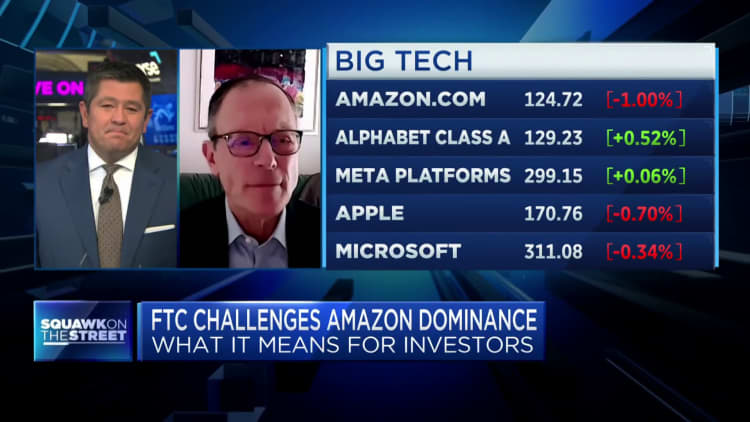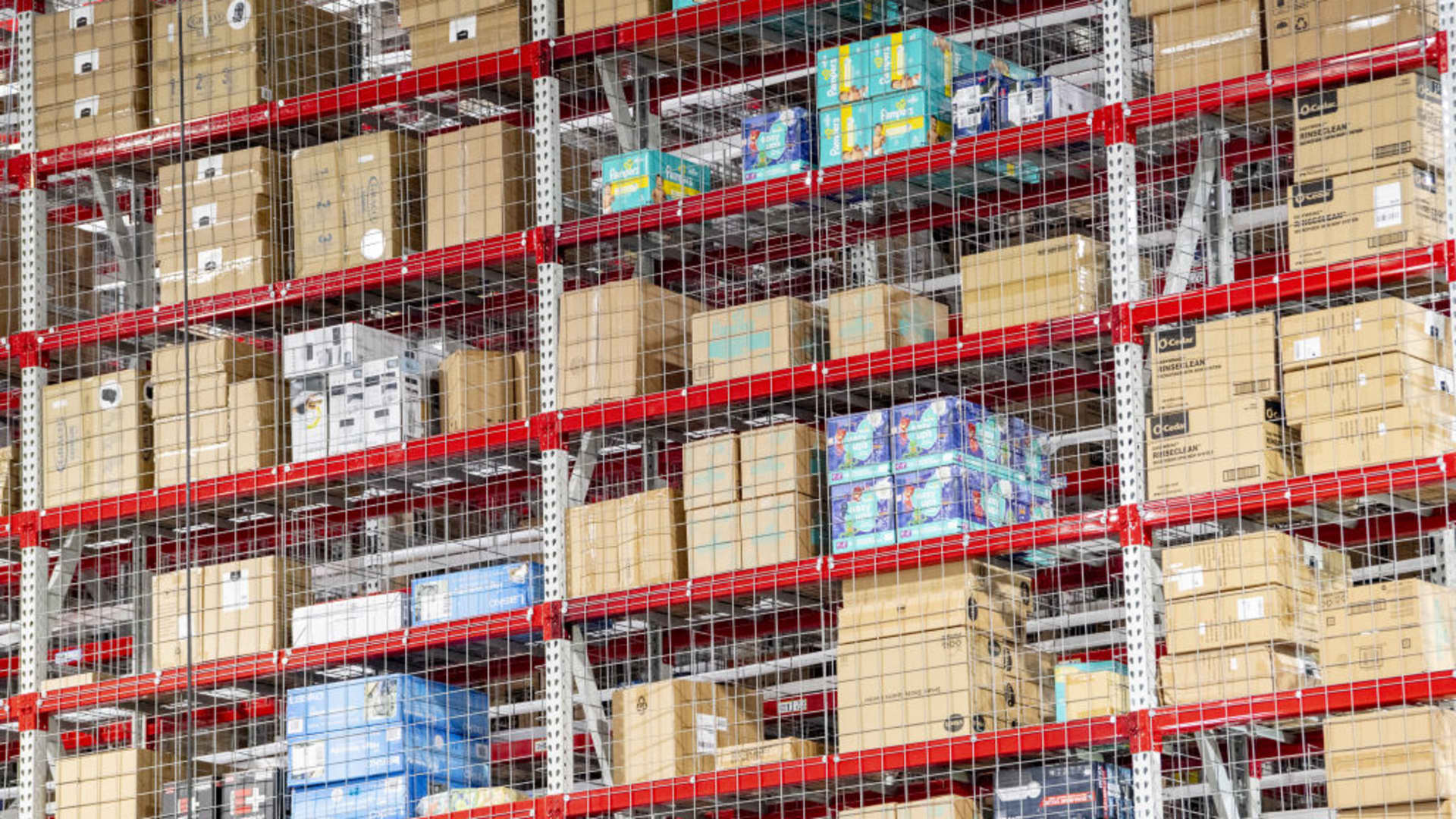Merchandise in a loading bay at an Amazon success middle on Prime Day in Melville, New York, US, on Tuesday, July 11, 2023. Amazon.com Inc.’s annual Prime Day exhibits that e-commerce is not the driving force it as soon as was for the inventory, as investor focus shifts to the corporate’s faster-growing and worthwhile cloud-computing unit. Photographer: Johnny Milano/Bloomberg by way of Getty Pictures
Bloomberg | Bloomberg | Getty Pictures
Amazon often is the epitome of huge enterprise, however greater than 60% of the behemoth’s gross sales final yr got here from small- and medium-sized companies. Small companies depend on Amazon for its attain and breadth, whereas Amazon wants unbiased sellers to fill its web site with merchandise.
However the relationship could be uneasy. Sellers have complained about rising prices to promote on the positioning. The Federal Commerce Fee antitrust lawsuit in opposition to Amazon, in the meantime, accusing the e-commerce big of wielding its “monopoly energy” to lift costs, stifle competitors and go away buyers with worse service. The lawsuit additionally accuses Amazon of forcing sellers to pay costly success and promoting charges, with little alternative however to depend on the e-commerce big to remain in enterprise.
“It is the identical playbook repeatedly,” mentioned Scott Lieberman, an e-commerce guide and founding father of TouchdownMoney.com. Corporations are “tremendous pleasant” to small companies at first to draw site visitors. Then the principles change, and it turns into more and more costly for companies to function on the platform, he mentioned.
Nonetheless, many small companies depend on Amazon as a significant a part of an e-commerce technique. Whereas amongst sellers just lately interviewed by CNBC there was a sense that the FTC case is “lengthy overdue,” they do not essentially agree with the entire FTC allegations. And so they aren’t certain a lot will change within the relationship.
“I believe that the facility that Amazon wields over sellers is appreciable and completely value wanting into,” Scott Needham, who each sells on Amazon and gives instruments to different sellers, instructed CNBC. “However I am undecided if this is able to really change that.”
Amazon‘s success has impressed others to observe go well with, permitting unbiased sellers to succeed in shoppers on extra e-commerce platforms. Shoppers shopped on huge marketplaces akin to Amazon and Walmart 30% extra in 2023 in contrast with 2022, in accordance with a latest survey by product advertising specialist 1Worldsync. Globally, gross sales from third-party on-line marketplaces are anticipated to be the fastest-growing retail channel over the subsequent 5 years, making up 60% of all world e-commerce gross sales development, in accordance with Edge by Ascential, a market analysis and consulting agency.
This shift to third-party sellers — like on-line bazaars — is altering the retail panorama, creating extra work for small companies. When promoting to first-party sellers, small companies might take care of a purchaser, ship in bulk, then receives a commission relying on how effectively the product sells. Companies typically have little management over how the product is positioned or marketed. However to do effectively on third-party marketplaces, firms should be extra hands-on with pricing, placement, promoting and extra. It is not sufficient simply to be within the market.
With important prices and complexity to succeed on Amazon and in wider world of e-commerce, listed below are keys that consultants say small enterprise homeowners must know.
You compete in opposition to your self on pricing
Amazon’s “anti-discounting technique” tracks costs on-line and punishes sellers who promote their product cheaper elsewhere by eradicating their itemizing from the coveted “click on to purchase” field. The FTC contends that Amazon’s “anti-discounting techniques” stop rivals from rising. E-commerce consultants say the pricing is hard and that stress to maintain costs lowest on Amazon makes it difficult for small companies to stability relationships with different e-commerce platforms.
“It is form of forcing you to be the most cost effective. Whereas you could have completely different economics on each platform,” mentioned Phil Masiello, founder and CEO of CrunchGrowth Income Acceleration Company,
Promoting on Amazon comes with important prices that add as much as virtually half the itemizing value — 15% to listing, one other 10% to fifteen% for Amazon’s success providers, and 15% to promote. However competing platforms, whether or not a vendor’s personal web site, Goal, Walmart or others include their very own value construction challenges. Corporations typically haven’t got management over how their merchandise are priced on different platforms. Corporations that promote direct to the patron should pay to retailer stock and pack and ship items. They have to additionally pay promoting prices. All these components have an effect on wholesale and retail pricing.
An increasing number of, small companies that promote on a number of platforms “are competing with themselves,” mentioned Randy Mercer, chief product officer at 1WorldSync, which helps sellers market their merchandise. “That is the bizarre factor that comes into play for smaller producers,” he mentioned. The pricing stress from Amazon and different third-party marketplaces could be laborious to resist. Mercer mentioned he is seeing extra small companies use analytic platforms to trace the place their merchandise are offered and at what value.
An Amazon spokesman mentioned the corporate’s strategy is to develop the success of our third-party promoting companions over the long-term, which in flip will increase choice for purchasers. He mentioned third-party sellers set their very own costs, and Amazon presents non-compulsory instruments to assist them in providing low, aggressive costs. The overwhelming majority of thousands and thousands of featured presents are priced as effectively or higher than at competing retailers, and if an “Add to Cart” button is eliminated when Amazon learns {that a} competitor sells the identical product for much less, it stays obtainable for buy.
Prices are important, however huge revenue margins are attainable
As Amazon has grown, its prices to sellers have additionally elevated. The FTC lawsuit focuses on stress on sellers to maintain costs low whereas additionally paying for success and promoting charges. Consultants say the prices could also be excessive, however the price construction is just not not like that of conventional bricks-and-mortar retail. The charges could also be important, however so is the attain. For many who create and promote a proprietary or branded product, “you’ll be able to attain lots of people and the amount of cash that you simply’d should spend to succeed in that quantity of individuals or drive them to your personal web site could be important,” mentioned Joe Camberato, CEO and founding father of Nationwide Enterprise Capital, a fintech market.
Many companies have been shocked by the work it takes to succeed on third-party marketplaces like Amazon. “Many manufacturers and startups, even established manufacturers, do not perceive the economics of their product,” Masiello mentioned. Many consumers hope to discover a technique to negotiate the itemizing and success charges, however the one technique to decrease costs, he mentioned, is thru tighter provide chain administration. Corporations must maintain product prices at 30% or much less, and together with FBA prices, promoting and overhead, most profitable sellers on Amazon ought to intention for a revenue margin of 10%, he mentioned.
Amazon contends that sellers who select to buy non-compulsory providers from Amazon accomplish that as a result of they supply extra worth than they’ll get elsewhere. Sellers who select to buy Amazon Advertisements, for instance, accomplish that as a result of they’ll efficiently attain prospects are prepared to purchase, the Amazon spokesman mentioned. Fulfilment by Amazon, he mentioned, stays a mean of 70% inexpensive than two-day delivery strategies supplied by different main third-party logistics suppliers.
The time for amateurs on Amazon is over
There was a time when amateurs might listing and promote merchandise on Amazon and generate income, however that point is up to now. Amazon has now additionally grown to be one of many web’s largest promoting platforms, behind Google and Meta, which owns Fb and Instagram. Getting a list to point out up on Amazon takes experience, very similar to SEO on Google.
“It’s a must to determine the Amazon method — their algorithm and perhaps even pay to sponsor your product and get it to the highest of that first web page” as one of many first few product listings, Camberato mentioned. “I do not suppose you are going to win by attempting to battle Amazon and you are not going to win by attempting to battle Google. You actually have to determine these algorithms and the best way to handle a funds round it,” he mentioned.


Related posts
Subscribe
* You will receive the latest news and updates!
Quick Cook!
Is it Unlawful to Demand a Return to Workplace?
The patterns of distant and versatile working that adopted the COVID-19 pandemic and lockdown restrictions are starting to waver, with…
The Startup Journal The way to Safe Short-term Startup Funding If You Don’t Have Traders But
Beginning a brand new enterprise is an thrilling journey, but it surely usually requires a big sum of money to…



